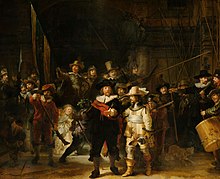Commission painting
As a commissioned painting images are called, which were painted because of a specific order. Oil paintings and wall paintings created as commissioned work have been part of artistic creation for centuries. In addition to the church, royal and princely houses were important clients for artists and painters. The rulers used art for propaganda purposes, but also to make themselves known and to put them in the right light. Noble and wealthy citizens such as B. Until the 19th century, merchants used the portraits , still lifes and landscapes they ordered to emphasize their economic success and social status . A significant proportion of the works of old masters such as Albrecht Dürer , Peter Paul Rubens , Caspar David Friedrich or Michelangelo Merisi da Caravaggio that are exhibited in renowned art museums around the world go back to orders from wealthy customers and patrons. One of the most famous paintings order is The Night Watch by Rembrandt van Rijn . He made this painting in 1642 for the Amsterdam Rifle Guild. The frescoes in the Sistine Chapel , especially by Michelangelo , were commissioned work.
With the spread of photography in the 19th century, the importance of commissioned portrait painting in Europe ebbed.
An artist's client differs significantly from a patron whose financial support is primarily determined by an enthusiastic interest in art and science, and not by an immediate benefit. The patron can certainly pursue his own interest, such as gaining a reputation, as it is deliberately used nowadays in sponsorship , but he does not demand any special consideration.
Approaches to a resurgence of order-related oil painting have been recorded for several years through the offers of internet-based painting workshops. Standardized production processes in connection with artist cooperations and favorable cost structures have again led to an increasing interest in individual oil paintings based on photos in Western Europe and the USA.
